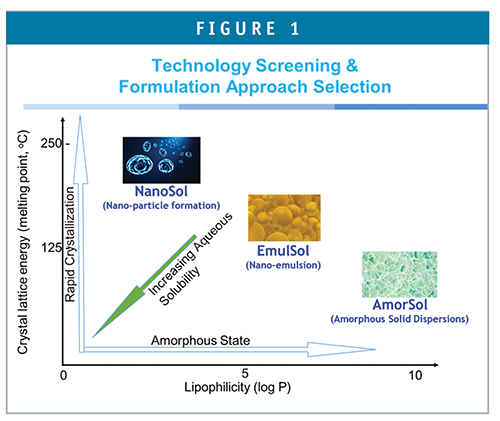Issue:May 2019
FORMULATION FORUM - Formulation Development From Preclinical to First-In-Human
Winning against all odds of “one approval out of every 5,000 to 10,000 compounds”
According to PhRMA July 2013 Profile, for every 5,000 to 10,000 compounds that enter the drug pipeline, only one receives final approval. There is only a 16% probability of being approved for compounds entering the Phase 1 stage. The average R&D budget for each new medicine is $1.2 billion, with more recent studies estimating the costs to be even higher.
When a compound enters preclinical development for a GLP tox study from the drug discovery stage, we face a question of how to develop a tox and clinical formulation that ensures the success of IND and first dose in human. According to Lipper, et al, poor biopharmaceutical properties of compounds is attributed to 39% of the failure of the new drug program under development.1 A compound with poor biopharmaceutical properties or improper formulation design could lead to a delay in the project or even program termination. The key considerations for successful tox and Phase 1 formulation development consist of the following:
-Pre-formulation of drug candidate
-Biopharmaceuticals evaluation
-Analytical method development
-Formulation development
-cGMP manufacturing for clinical trials
PRE-FORMULATION CHARACTERIZATION
One of the primary goals of preformulation studies is to identify the physicochemical characteristics of a drug candidate that predict drug product performance in-vitro and in-vivo. Pre-formulation studies usually cover the following items: pKa, LogP/LogD, Ph solubility curve, pH stability curve, solvent solubility, particle size distribution, hygroscopicity, API solid-state stability under stressed temperature/humidity conditions, melting point, salts form evaluation, polymorph/hydrate/solvate evaluation, forced degradation under different stressed conditions (light, heat, oxygen, acidic, and alkaline pH, etc), stability-indicating analytical methods for characterization of active, and impurities.
Those parameters are important to guide the selection of a potential drug candidate and to determine future formulation strategies.
BIOPHARMACEUTICAL ASSESSMENT
The biopharmaceutical properties generated during the drug candidate selection process, which is critical for the next step of formulation development and for selection of formulation technologies, include compound dissolution in simulated gastric and intestine fluids, solubility, and stability in simulated GI fluids, enzymatic stability, intestine membrane permeability, and modeling and simulation of animal and human PK and bioavailability. The steps in the absorption process include the disintegration and dissolution of the compound from the solid dosage form into the gastrointestinal lumen. The potential limiting steps for absorption of the compound through the GI membrane (including dissolution, solubility, and permeability limited process) should be fully understood. A thorough biopharmaceutical characterization will minimize the risk of selection of a poorly designed formulation, and allow for an efficient, science-based formulation development process.
According to the FDA biopharmaceutics classification system (BCS), drug compounds can be classified into four classes based on their solubility and permeability (bioavailability). Based on the BCS classification of the drug candidate, different formulation strategies can be explored. If a drug candidate is predicted to be BCS I (soluble and permeable), a simple formulation strategy can be employed for the GLP tox and first-in-human studies. Neat compounds can be filled in bottles (drug in bottle) or into capsule (drug in capsule). However, if a compound does not wet easily, has a low dose, has a bad taste, or has a poor flow properties, a formulated powder blend of drug-excipient, capsule-containing granulation, or immediate-release tablet could be utilized to facilitate the dissolution, content uniformity, and taste-masking.
For BCS III compound (soluble, but poor permeability), excipients with permeation-enhancing properties may be required to ensure enough oral bioavailability. For example, for soluble peptides, a lipid formulation encapsulated in a bead, or a capsule with enteric coating could help enhance absorption of the peptide in the intestine while protecting its gastric degradation in the stomach.
If a drug molecule is predicted to have challenging oral bioavailability [BCS II (insoluble, but permeable), or IV (insoluble, poor permeability)], choosing an appropriate formulation strategy for tox and human Phase 1 is critical to ensure the solubility and bioavailability of those drug candidates is maximized in order to realize its full potential for safety and efficacy evaluation in animal and human. Other routes of administration, such as injectable, topical, and nasal routes, can be considered for BCS III and IV compounds.
ENABLING FORMULATION TECHNOLOGIES
For challenging compounds, there are several enabling formulation approaches, ranging from salt form formation, solution formulation by pH control, co-solvent or complex formation, particle size reduction by micronization/nanosizing, lipid formulation (SEDDS and emulsion), amorphous solid dispersions, and nanoparticles.
A guided formulation selection tree can be followed in junction with considerations in route of administration, phase of development, target patient population, freedom of operation, available technology in house, and marketing considerations.2 Figure 1 shows the general rule of thumb in selection of formulation technology based on compound properties in melting point and lipophilicity.

Salt Form Selection
Salt form formation is an effective way to modify the solubility of molecules with ionizable functional groups (pKa). Selection of an appropriate solid form (polymorph, hydrate, or salt) for a compound is a key activity for drug development. Salts are usually considered when the physicochemical characteristics of the free acid or base pose problems in formulation and process, including issues in solubility, stability, size reduction, polymorphism, and bioavailability of the parent compound through changes in compound solubility and dissolution rate.
Solution Formulation
Solubility of weakly acidic or basic compounds can be increased by a pH-controlled solution approach. Cyclodextrin, surfactant, polymer, and co-solvents, such as propylene glycol, polyethylene glycol, glycerin, etc, may also be added to further increase compound solubility in those media. One major limitation using pH-adjusted and co-solvent systems is potential drug precipitation once the formulation is administered into the body by oral or IV routes, which may cause implications in injection pain, thrombophlebitis, variable PK profiles, and bioavailability. While cyclodextrin-based solution alone does not exhibit such precipitation phenomenon, the extent of solubility enhancement could be limited by cyclodextrin solubility and the maximum allowable daily dose of cyclodextrin due to its potential side effects at a high dose.
Size Reduction by Micronization or Nanosizing
For compounds with a high melting point and with a dissolution-limited absorption process, the dissolution rate and bioavailability of the drug substance can be significantly increased by reducing the particle size of the API. Micronization by fluid energy mills, such as jet milling, can efficiently reduce the average particle size down to below 10 microns, whereas using bottom-up (solution precipitation) and top-down (wet milling) processes can be used to produce nano-sized API below 300 nm. For insoluble compounds, reduction of particle size to submicron and nano levels not only could increase drug dissolution and bioavailability after oral administration, but has also demonstrated to reduce or eliminate food effect for some commercial products. Screening of polymer, surfactant, and stabilizer is required to ensure the physical stability and in-vivo performance of suspensions. Suspension is amenable to pediatric or geriatric formulations with addition of sweeter or taste-masking agents.
Lipid Emulsion Formulation
For lipophilic compounds with high logP values and a low-to-intermediate melting points, lipid formulations could be a good option for oral dosage forms of BCS II and IV compounds. Solution or liquid-filled capsules can be chosen for the first-in-human formulation. To overcome significant inter- and intra-subject variation in drug uptake observed on some macroemulsion systems (dispersion as coarse emulsion after administration to GI fluid), addition of surfactants to the lipidic excipients are frequently used to produce spontaneous self-emulsifying drug delivery systems (SEDDS) and self-microemulsifying drug delivery systems (SMEDDS) for compounds with poor water- solubility. However, there have been some challenges, such as chemical instability of compounds due to oxidation, capsule incompatibility, and tolerability issues, resulting from high level of surfactants, etc. Pre-formed nanoemulsions manufactured by a high-energy process to reduce the oil droplets to a nano level enjoys the same benefits of microemulsions, except they are more tolerable for patients due to significant reduced level of surfactant(s), which is suitable for different routes of administration, such as IV, SC, topical, oral dosage forms, and in some cases, vaccine adjuvant.
Nanoparticles
There are different types of nanostructured particles for use in the pharmaceutical field, which include nanostructured lipid carriers, solid lipid nanoparticles, liposomes, polymeric nanoparticles, and superparamagnetic nanoparticles, etc. Nanoparticles could overcome the limitations of traditional methods and bring new ways of delivery of therapeutic drugs for treatment of different disease areas, such as cardiovascular, CNS, immunology, cancer, imaging, and nutraceuticals. Through controlling the particle size, surface properties, drug loading, and release rate, drugs can be delivered to enhance bioavailability, to sustain for longer period of time with less frequent dosing (long-acting delivery), or to target certain organs/tissues inside the body that are difficult to reach by conventional means.
There are different ways to prepare the nanoparticles: solvent evaporation, solvent injection, extrusion, emulsification, melt-emulsification, emulsification-solvent evaporation, milling, homogenization, microfluidization, or combined methods. Thorough understanding of the nanoparticle structure and its physical chemical properties in relationship with in-vitro and in-vivo performance is the key to further advance those technologies into the market.
Amorphous Solid Dispersion
For compounds with low-to-medium melting points, amorphous solid dispersions, where drug exists as a discrete particle dispersed within a polymer matrix, has dual strategy to enhance the aqueous solubility of a compound: 1) conversion of compound to an amorphous state, 2) reduction of compound particle to a molecule level, both of which enhance drug kinetic solubility and dissolution rate. Amorphous solid dispersion can be manufactured by spray drying, hot-melt extrusion, milling, or solvent-evaporation process. An excipient screening study should be employed to select polymer(s) or surfactant(s) that are not only miscible and chemically compatible with drug compounds, but also enhance compound solubility and physical stability at its amorphous state. Amorphous solid dispersions can be an effective approach for oral, transdermal, or inhalation routes to achieve greater exposure for drug compounds with poor solubility and high dose requirement.
REFERENCES
- Lipper et al. J. Pharm. Sci., 89(2) 145, 2000. https://jpharmsci.org/article/S0022-3549(16)30559-7/fulltext.
- Huang et al. Drug Development and Delivery, March 2019. https://drug-dev.com/formulation-forumformulation-research-strategy-for-discovery-stage-new-drugcandidates/.

Jim Huang, PhD
Founder & CEO
Ascendia Pharmaceuticals
j.huang@ascendiapharma.com
www.ascendiapharma.com
Total Page Views: 7973















